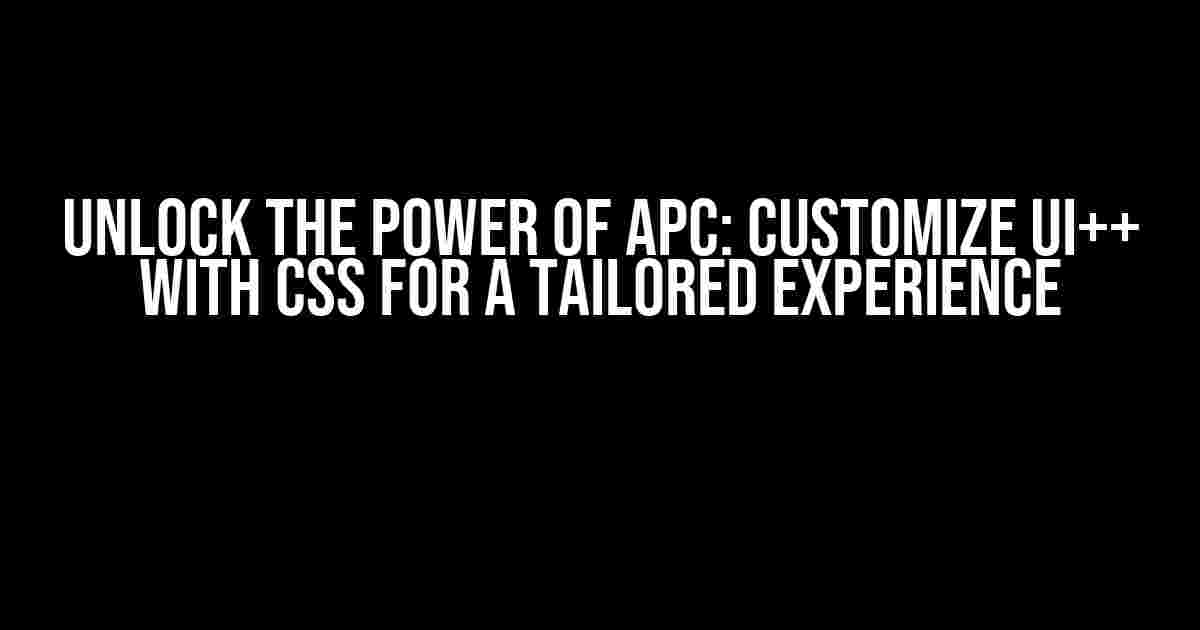Are you tired of the plain and generic look of your APC (American Power Conversion) UPS (Uninterruptible Power Supply) monitoring interface? Do you want to give it a personal touch that reflects your brand or style? Look no further! With UI++ and some CSS magic, you can unlock the full potential of APC customization. In this comprehensive guide, we’ll show you how to take your APC UI++ to the next level with CSS customization.
What is UI++?
UI++ is a web-based interface developed by APC for monitoring and managing their UPS systems. It provides a centralized platform for monitoring, configuring, and controlling APC devices. UI++ is designed to be user-friendly, but its default layout and design might not meet your specific needs. That’s where CSS customization comes in.
Why Customize UI++ with CSS?
Customizing UI++ with CSS offers numerous benefits, including:
- Enhanced branding: Match UI++ with your company’s brand colors, logo, and style.
- Improved user experience: Tailor the layout and design to your specific needs and workflow.
- Increased efficiency: Create a more intuitive interface that reduces clutter and streamlines navigation.
- Unlimited creativity: Use CSS to unlock new design possibilities and make UI++ truly unique.
Prerequisites
Before diving into CSS customization, make sure you have:
- An APC UPS device with UI++ enabled
- A basic understanding of HTML and CSS
- A code editor or IDE (Integrated Development Environment) of your choice
- Access to the UI++ web interface (login credentials may be required)
Step 1: Accessing the UI++ Web Interface
Open a web browser and navigate to the IP address of your APC UPS device. The default IP address is usually 192.168.1.100, but this may vary depending on your device and configuration. Log in to the web interface using your admin credentials.
Step 2: Enabling Custom CSS
In the UI++ web interface, navigate to Configuration > Advanced > Web Interface. Scroll down to the Custom CSS section and enable the feature by checking the box. You’ll see a text area where you can paste your custom CSS code.
<!-- Enable Custom CSS --> <input type="checkbox" id="custom_css_enabled" name="custom_css_enabled" /><label for="custom_css_enabled">Enable Custom CSS</label> <textarea id="custom_css" name="custom_css"></textarea>
Step 3: Writing Custom CSS Code
In your code editor, create a new file and start writing your custom CSS code. We’ll provide some examples and guidelines to get you started. Remember to follow the CSS syntax and formatting rules.
/* APC UI++ Custom CSS File */
/* Change the background color of the navigation menu */
#nav {
background-color: #333; /* Dark gray */
}
/* Customize the logo */
.logo {
width: 50px; /* Resize the logo */
margin: 10px; /* Add some margin */
}
/* Style the alerts and warnings */
.alert {
background-color: #FFC107; /* Yellow-orange color */
padding: 10px;
border-radius: 5px;
}
/* Change the font family and size */
body {
font-family: 'Open Sans', sans-serif;
font-size: 16px;
}
Step 4: Applying Custom CSS Code
Copy your custom CSS code and paste it into the Custom CSS text area in the UI++ web interface. Click the Apply button to save your changes. Refresh the UI++ page to see your customizations in action.
| Selector | Property | Value |
|---|---|---|
| #nav | background-color | #333 |
| .logo | width | 50px |
| .alert | background-color | #FFC107 |
| body | font-family | ‘Open Sans’, sans-serif |
Advanced Customization Techniques
Now that you’ve got the basics covered, it’s time to explore more advanced customization techniques:
Using CSS Pseudo-Classes
CSS pseudo-classes allow you to target specific states or conditions. For example, you can use the :hover pseudo-class to change the background color of a button when the user hovers over it.
button:hover {
background-color: #4CAF50; /* Green color */
cursor: pointer;
}
Creating Custom Icons
You can replace the default icons in UI++ with custom ones using CSS. Simply create a new class for your icon and use the background-image property to specify the icon file.
.custom-icon {
background-image: url('custom-icon.png');
background-size: 20px 20px;
background-position: center;
height: 20px;
width: 20px;
}
Styling Tables and Grids
UI++ uses tables and grids to display information. You can customize the appearance of these elements using CSS. For example, you can change the border style, padding, and background color.
table.data-grid {
border-collapse: collapse;
border: 1px solid #ccc;
}
table.data-grid th {
background-color: #f0f0f0;
padding: 10px;
}
table.data-grid td {
padding: 10px;
border-bottom: 1px solid #ccc;
}
Best Practices and Troubleshooting
When customizing UI++ with CSS, keep the following best practices and troubleshooting tips in mind:
- Use a consistent naming convention for your custom CSS classes.
- Test your custom CSS code in different browsers and devices.
- Use the browser’s developer tools to inspect and debug your CSS code.
- Keep your custom CSS code organized and commented for easier maintenance.
- If you encounter issues, try removing your custom CSS code and re-applying it incrementally to identify the problem.
Conclusion
Customizing UI++ with CSS is a powerful way to tailor the APC monitoring interface to your specific needs and brand identity. With these instructions and guidelines, you’re ready to unlock the full potential of UI++ and create a unique, efficient, and visually appealing experience. Remember to explore, experiment, and push the boundaries of what’s possible with CSS customization.
Happy customizing!
Frequently Asked Questions
Get answers to your pressing queries about APC Customize UI++ CSS customization!
What is APC Customize UI++ and how does it help with CSS customization?
APC Customize UI++ is a powerful tool that allows you to easily customize the UI of your application with CSS. It provides a user-friendly interface to modify and extend the existing UI, giving you complete control over the look and feel of your app.
What kind of CSS customization can I do with APC Customize UI++?
With APC Customize UI++, you can customize almost every aspect of your app’s UI, including layout, typography, colors, and more. You can also create custom CSS classes, modify existing ones, and even add your own custom CSS files to give your app a truly unique look.
Do I need to have extensive CSS knowledge to use APC Customize UI++?
No, you don’t need to be a CSS expert to use APC Customize UI++. The tool provides an intuitive interface that makes it easy to customize your app’s UI, even if you have limited CSS knowledge. However, having some basic understanding of CSS will certainly help you get the most out of the tool.
Can I use APC Customize UI++ for other types of customization beyond CSS?
While APC Customize UI++ is primarily designed for CSS customization, it can also be used for other types of customization, such as modifying the layout, adding custom icons, and more. The tool provides a flexible framework that allows you to extend its capabilities to meet your specific needs.
Is APC Customize UI++ compatible with all types of applications?
APC Customize UI++ is designed to be compatible with a wide range of applications, including web apps, mobile apps, and desktop apps. However, the tool’s compatibility may vary depending on the specific requirements of your app, so it’s always a good idea to check the tool’s documentation or contact the developers for more information.



